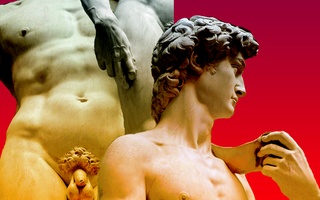John Singer Sargent had a singular talent for swathing his portrait subjects in an exotic and provocative mystique.
His famed “Madame X,” an image of a society lady with a bared shoulder, scandalized the Parisian Salon in 1884 and got the turn of the century painter chased out of France.
Less known about his career, though, is that six years later he shifted his focus from the profane to the sacred, undertaking a massive mural cycle for the Boston Public Library. Sargent’s “Triumph of Religion” is now being restored for the first time in a half-century by the Harvard University Art Museums’ Straus Center for Conservation.
Installed in four segments between 1895 and 1919, the murals depict what Sargent considered the progress of religious experience through history, a successive falling-away of “external” forms, cult and creed, toward an “internal” spiritual communion.
It’s a “pretty extraordinary thing” to restore Sargent’s murals, says Gianfranco Pocobene, a paintings conservator involved in the restoration.
And the project is particularly unique, Pocobene says, due to “the stature of Sargent himself as an artist”—and because “it’s so different from what we usually deal with.”
And Sargent’s murals stand out—not only from the frescos of da Vinci and Michaelangelo, but also from more modern works. Unlike his predecessors in the mural tradition, Sargent used a wide range of available media, including gilded statuary and a plethora of other relief materials. Consequently, the Straus Center has had to allocate four or five conservators with differing specialties to the project.
When he painted the murals, Sargent had total decorative control over what is now the library’s Sargent Hall.
“Artists just aren’t given this kind of freedom to embellish the space today,” says Pocobene.
While all the murals are accessible on a special website set up by the Boston Pubilc Library, this restoration will soon include an unlikely frill: a kiosk below the scaffolding with a webcam that will broadcast all the touch-ups live to that site.
“It’s going to be set up in the next few weeks,” says Pocobene, who doesn’t expect restoration work to end before December.
In general, Sargent’s contemporaries viewed his interpretation of worship as progressive, though one aspect remains controversial today.
His panels chronicle religion from its most “material” phase, represented by “the idols of Canaan” (Moloch, Astarte and Neith), through the early, “dogmatic” Christian church (represented by the Crucifixion and allegorical visions of church and synagogue) toward a more inner, “spiritual” phase (represented by the Sermon on the Mount).
Yet what has piqued some library-goers since 1919, irrespective of their faith, was Sargent’s symbolism of the synagogue as a blind old woman—a reference to the medieval convention signifying the failure of Judaism to see the truth of Christianity. By contrast, Sargent portrayed the church as wide-eyed and demurely poised atop a throne-like seat.
Controversy erupted even before the panels were installed.
Read more in Arts
New MusicRecommended Articles
-
Harvard Team Discovers Mayan MuralsA team of Harvard-led archeologists in Guatemala have discovered a section of what they say appears to be the oldest
-
Murals Challenge Harvard ConservatorsBattling years of grime with cotton swabs, gentle solvents and boundless patience, a group of Harvard conservators has begun restoring
-
Notices.GLEE CLUB AND PIERIAN ASSOCIATION. Members are reminded that no unsold tickets will be received at Sever's after this evening.
-
Basket Ball.Dr. Sargent is at present trying to arrange to have two basket ball teams from outside the college, composed of
-
 Naked in the Archives
Naked in the Archives













